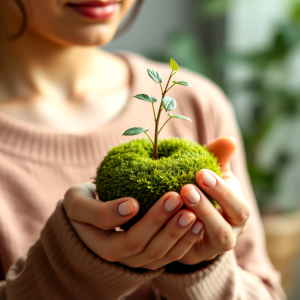
Imagine a tiny world suspended in mid-air, where delicate ferns emerge from a sphere of emerald moss, or where succulents sprout from perfectly round globes hanging like natural ornaments in your home. This is the enchanting world of kokedama, the Japanese art of creating “moss balls” that transform ordinary houseplants into living sculptures. These botanical masterpieces have captured the imagination of plant enthusiasts worldwide, offering a unique blend of traditional Japanese aesthetics and modern interior design.
Kokedama, which translates to “moss ball” in Japanese, emerged from the ancient art of bonsai during the Edo period (1603-1867). This distinctive style developed as a variant of nearai, a practice of growing plants in clay pots without drainage holes. Creative gardeners began removing plants from their containers altogether, wrapping their root systems in moss and twine, thus giving birth to what we now know as kokedama. This form of cultivation represents the Japanese concept of wabi-sabi, which finds beauty in imperfection and simplicity.
What makes kokedama particularly fascinating is its role in Japanese string gardens, or “kusamono.” These aerial gardens feature multiple kokedama suspended at different heights, creating living installations that defy gravity. In traditional Japanese displays, kokedama were often presented on handcrafted wooden slabs called “bon,” allowing viewers to appreciate their sculptural quality from various angles.
The Western world discovered kokedama in the early 2000s, and its popularity exploded with the rise of social media platforms like Pinterest and Instagram. The appeal lies in its versatility – kokedama can be created with virtually any plant with a compact root system, from orchids to herbs, and can be displayed in countless ways. Interior designers and plant enthusiasts have embraced kokedama to bring nature indoors while maintaining a minimalist aesthetic.
Creating your kokedama is like participating in a meditative craft project. The process begins with selecting the right plant – ones with small root systems work best, such as ferns, peperomias, small philodendrons, or air plants. The next step involves creating the perfect soil mixture, typically combining regular potting soil with bonsai soil, peat moss, and akadama (a special clay soil from Japan). This mixture is formed into a ball around the plant’s roots.
The real magic happens when wrapping the soil ball with moss. Sheet moss works best, as it creates a seamless, living green surface. The moss not only adds aesthetic appeal but also helps retain moisture and provides essential humidity for the plant. The entire creation is then bound with natural twine or fishing line in an intricate pattern that both secures the moss and adds visual interest.
One lesser-known aspect of kokedama is its connection to the Japanese tea ceremony. Small kokedama were sometimes displayed in tea rooms as accent pieces, carefully chosen to reflect the season and create a harmonious atmosphere. This tradition highlights the Japanese attention to detail and the importance of connecting with nature daily.
Caring for kokedama requires a unique approach to watering. Instead of traditional watering from above, kokedama are typically soaked in water for 10-15 minutes when they feel light or when the moss begins to dry out. This soaking method allows the entire ball to absorb water evenly, ensuring the plant’s roots receive adequate moisture. Between soakings, misting the moss helps maintain humidity and keeps the ball looking fresh.
Part of kokedama’s charm is its versatility in display options. They can be placed in shallow dishes, arranged on driftwood or decorative stones, or suspended from the ceiling using decorative macramé hangers or simple twine. Some enthusiasts create elaborate installations with multiple kokedama hanging at different heights, creating the effect of a floating garden. Others prefer to showcase single specimens on minimalist stands, allowing each piece to be appreciated as an individual work of art.
Modern interpretations of kokedama have led to innovative variations. Some artists use colored moss or alternative wrapping materials, while others incorporate air-purifying plants to create functional art pieces for urban spaces. There’s even a trend of creating miniature kokedama barely larger than a golf ball, perfect for tiny spaces or as unique gift items.
Making and maintaining kokedama has therapeutic benefits that many practitioners discover along the way. Creating these living sculptures requires focus and patience, making it an excellent mindfulness exercise. The regular care routine of misting, soaking, and rotating the balls becomes a peaceful ritual that connects us with nature and helps reduce stress.
As our lives become increasingly digital and disconnected from nature, kokedama offers a way to bring the outside world into our homes in an artistic and meaningful way. These living sculptures remind us of the beauty of simplicity and the importance of caring for something that grows and changes over time. Whether displayed as a single statement piece or as part of a larger installation, kokedama continues to evolve while maintaining its connection to its Japanese roots.
The art of kokedama is more than just a trendy way to display plants – it’s a practice that connects us to ancient traditions while allowing for modern interpretation and creativity. As we continue to seek ways to incorporate nature into our living spaces, these moss balls serve as perfect ambassadors between the natural world and our contemporary lives. Whether you’re a seasoned plant parent or just beginning your journey with houseplants, creating and caring for kokedama offers a unique and rewarding way to explore the intersection of gardening, art, and mindfulness.
